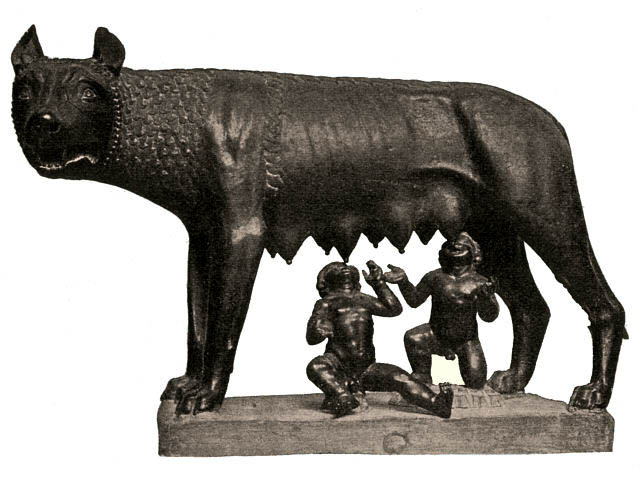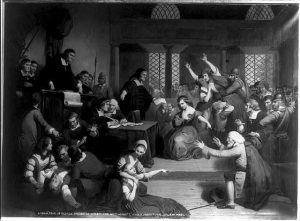A famous Roman myth celebrates the founding of the city of Rome. It is the story of the twin brothers Romulus and Remus. This story inspired the Romans and was seen by them as a strong symbol of their origins. The images of Romulus and Remus can be found on ancient coins of the Roman empire, and if one visits today the glorious city of Rome, one can see many statues and symbols depicting aspects of their story. So, what is the myth of the founding of Rome?
The story of Romulus and Remus starts in the Kingdom of Alba Longa. Its King Numitor was overthrown by his younger brother, Amulius. Numitor could not get revenge against Amulius because Amulius killed his nephews. The only member of the family that was left was Numitor’s daughter, Rhea Silvia. Amulius forced Rhea to become a vestal virgin so that she would not be able to have any legitimate offspring who might return and overthrown Amulius.1 It is said that by destiny, a man took Rhea Silvia and forcibly violated her, giving birth to twins. She said that it was Mars, the God of War, who was the father of the two babies.2 She named her twins Romulus and Remus.

But the twins’ births did not bring Rhea Silvia happiness. Amulius felt that his reign would eventually be in danger. He ordered the imprisonment of Rhea Silvia, and the two babies were to be thrown into the Tiber river. And at that moment, the river was in a raging flood, and the servants of the king, thinking that they were following his orders correctly, placed the babies along the shore in the overflow. The babies were later found washed up on the shore of the river by a she-wolf.3 The legend says “a thirsty she-wolf from the surrounding hills, attracted by the crying of the children, came to them, gave them her teats to suck and was so gentle towards them that the king’s flock-master found her licking the boys with her tongue.”4 The name of shepherd was Faustulus, and he, along with his wife, Laurentia, kept the boys and raise them as their own sons.5
Romulus and Remus grew up as shepherds, but also as boys with lots of strength and courage. They liked to demonstrate their abilities by assaulting local bandits.6 One day, while the boys were at a festival, the bandits assaulted Romulus and Remus because the boys had taken their loot. Romulus defend himself, but Remus was captured and the bandits brought him before the King, Amulius. The bandits accused Remus of committing the crimes that they had actually committed. Amulius sent Remus to Numitor so that he could hand Remus his punishment. The two brothers, once reunited, planned a revolt. Romulus attacked directly Amulius’s palace from the outside along with shepherds who supported him. And Remus, along with Numitor and his supporters, attacked from the inside. The attack was a success and Amulius was killed.7 Numitor then called a council to explain the whole situation to the people of Alba Longa. At the end, Numitor was congratulated by the people and was given back the title of King of Alba Longa.8
There are different versions of the myth that explain how Romulus and Remus found out about their own past and their true genealogy and the events that followed Remus’ capture. In the version of Plutarch, the author of the Life of Romulus, Faustulus told Romulus about his past to inspire him to save his brother, but Romulus, along with Remus, knew some of their past because of their encounters with the bandits. In Plutarch’s version, Remus and Numitor recognized that they were family during the attack on the palace. But according to the Greek historian Dionysus of Halicarnassus, it was Faustulus who told Romulus that he and his brother were the grandsons of the former King of Alba Longa, Numitor. And after the assassination of Amulius, Romulus gathered Remus and Numitor and then told Remus that they were actually Numitor’s grandsons.9 In the version of the Roman historian, Livy, Faustulus was the one who finally told Romulus that he and his brother were actually the grandsons of Numitor. At the same time, Numitor discovered that Remus had a twin brother, and, looking at their ages and family resemblance, he realized that Remus was actually his grandson.10
After Numitor went back to being the King of Alba Longa, Romulus and Remus decided to create their own kingdom, and every kingdom starts with a city. They wanted their city to be much bigger than their grandfather’s and much bigger than its neighbor city Lavinium. All the preparations were ready for the twins to start their own city, but it was interrupted by the worst curse: ambition. Because there was no land that was inherited and because both were born at the same time, their first dispute was over whose name would be used to name the city.11 They both called for the deities to decide for them with an omen. Six vultures appeared in Remus’ sight. Suddenly, twelve vultures appear to Romulus. Remus said that because he saw the vultures first, he should be the king. Romulus, for his part, said that because the number doubled, he should be the king.12 They separated and each one went to a different hill to start his own city. Remus went to the Aventine hill and Romulus went to the Palatine hill to create what would be his future city.13 Between the dispute and the tensions between the two brothers, Remus died. Romulus then became the founder of his city and he named it after himself, Rome.
Many versions exist about the death of Remus. In Livy’s and Ennius’s versions of the myth, Remus leaped over Romulus’s wall and was then killed by Romulus. In Ennius’s version, Romulus declared, “Neither you nor any man shall do this with impunity. You will recompense me with your life blood.”14 In Livy’s version, Romulus declared, “So shall it be henceforth with every one who leaps over my walls.”15 In Dionysus’s and Ovid’s versions, Remus was killed in a brawl, but they never gave the name of Romulus as the killer. In Dionysus version, it was a guard called Celer who killed Remus when Remus leaped over Romulus’s walls. Also, both authors stated that Romulus gave his brother an honorable funeral in his name.16

Romulus then founded his kingdom of Rome. First, he fortified the new city by creating its protective walls. Then he established its religion. And then he called for twelve lictors (twelve for the number of vultures he saw), and created a political constitution. And because the city was starting to grow, he built an Asylum under the Capitol in order to protect his subjects. And finally, he appointed a hundred senators to be called “Patricians” so that his city could be wisely direct by a Senate.17 Rome was now at the same level as its neighbors.
The new Kingdom of Rome was at peace, but because there were no women in the population, the city wouldn’t last more than one generation without women. Romulus decided to create an event called “the Consualia,” and he invited people from neighboring cities to the event. From the cities of Caenina, Antemnae, and Crustumerium, people wanted to see how Rome had rapidly developed. Also, the whole tribe of the Sabines went to Rome to see for themselves their neighboring city. When the celebration started and everyone was distracted, Romulus called for his men to take all the women they saw and kidnapped them so that they would have wives, who would be the mothers of their descendants.18 This event was later known as the “Rape of the Sabines,” but it wasn’t only the Sabine women who were abducted, but also the women from neighboring cities.
After the “Rape of the Sabines,” the cities of Caenina, Antemnae, and Crustumerium wanted their women back, but the Caeninasians did not wait to plan a strategy to get them back. Instead, they went directly to Rome to fight. Romulus brought out his army and he won the battle. He slayed their leader and took the city of Caenina. Romulus was so anxious to demonstrate his first achievements as king that he went up to the Capitol and hung the body of the Caeninasians’ king in a sacred tree, marking that site as the temple of Jupiter that he would one day build. Romulus declared the following: “Jupiter Feretrius! these arms taken from a king, I, Romulus a king and conqueror, bring to thee, and on this domain, whose bounds I have in will and purpose traced, I dedicate a temple to receive the spolia opima, which posterity following my example shall bear hither, taken from the kings and generals of our foes slain in battle.”19 While the Romans were thus distracted, the Antemnates attacked, but Romulus rapidly took his legion against them and defeated them too, and took their city. Romulus’ wife, Hersilia, implored Romulus that instead of killing the Antemnates, to accept them into their city, so that Rome would grow and become an even more powerful kingdom. Romulus accepted. After their two victories, Romulus and his army went to face the Crustuminians. The Crustumnians had no hope and they were defeated easily by the Romans. With the defeat of all three neighboring cities, Rome grew more and more, and they just had one enemy left, the Sabines.20

The war with the Sabines would not be an easy one for the Romans. The Sabines prepared every soldier they had and planned every strategy possible, so that they would not fall before the Romans. Titus Tatius, the king of the Sabines, and his army attacked Rome, and took the Roman Citadel. Determined to recover it, Romulus sent Hostius Hostiulus, who was in command of the Roman legion. They encountered the commander of the Sabines, Mettius Curtius, in a battle face to face. The Sabines advanced to the gates of the Palatine hill. Romulus looked for help in Jupiter, king of the gods, and exclaimed: “Jupiter, it was thy omen that I obeyed when I laid here on the Palatine the earliest foundations of the City. Now the Sabines hold its citadel, having bought it by a bribe, and coming thence have seized the valley and are pressing hitherwards in battle. Do thou, Father of gods and men, drive hence our foes, banish terror from Roman hearts, and stay our shameful flight! Here do I vow a temple to thee, ‘Jove the Stayer,’ as a memorial for the generations to come that it is through thy present help that the City has been saved.” Romulus, feeling that he was heard by Jupiter, screamed to his soldiers: “Back, Romans! Jupiter Optimus Maximus bids you stand and renew the battle.” Romulus went in front of his army. At the same time, Mettius, now very close to the gates of Palatine hill, shouted “We have conquered our faithless hosts, our cowardly foes; now they know that to carry off maidens is a very different thing from fighting with men.” The Romans, inspired by their leader, attacked the Sabines. Romulus fiercely attacked Mettius. Because Mettius was on horse, he could not control it with all the battle and shouting. He fell into a lake. Mettius was shaken up after the fall, but his soldiers shouted to him to concentrate on the battle. The battle now turned in favor of the Romans.21 The Sabine women all of a sudden appeared on the battlefield to stop their parents and their husbands from killing one another. The women cried, “you are weary of these ties of kindred, these marriage-bonds, then turn your anger upon us; it is we who are the cause of the war, it is we who have wounded and slain our husbands and fathers. Better for us to perish rather than live without one or the other of you, as widows or as orphans.” Both sides, moved by this appeal, decided to stop the fighting and organize a treaty in which the Sabines and the Romans would unite and make Rome the capital with Romulus and Tatius as kings. Rome was finally at peace.22
The peace endured for some years, until Titus Tatius destroyed it. Some of his men killed the ambassadors of the neighboring city of Lavinium, who were seeking a treaty between Lavinium and Rome. Titus Tatius thought that it was more important to protect his men than the future of Rome. As punishment, Romulus sent Titus Tatius to celebrate an annual sacrifice in Lavinum. At the event, a disturbance happen that resulted in the assassination of Titus Tatius. Romulus decided that instead of going to war with the Laviniums over what had happen to Tatius, he would instead make a treaty with the Laviniums. Although Rome was back under the power of Romulus and the treaty of peace was made with the Laviniums, peace was not secured anymore.23
During the next years, Romulus was the sole king of Rome. He went to war with many neighbor cities. The first city he attacked was Fidenae. The Fidenates believed that because Rome was becoming more and more powerful, they would be invaded next by Rome, to expand Rome’s ever-growing power. So, the Fidenates advanced to Rome, but they did not count on Romulus’s strategy. Romulus prepared an ambush and attacked them from all sides. The Fidenates tried to flee back to their city, but were stopped.24 After their victory over the Fidenates, another neighboring city tried to attack Rome. The Veientes were convinced that if they did not stop Rome, Rome would continue to expand its reign. But because the Romans were known experts in the art of war, the Veientes fell under their power. The Veientes did not have any more option than to make a treaty with Rome for peace. Romulus accepted the treaty that would last a hundred years. Rome was finally once again at peace.25
After all his years of reigning as king, and all his accomplishments after his successful founding of Rome, Romulus disappeared. There are many versions about how he disappeared. Ennius said that “Romulus lives for ever in the sky with the gods that gave him birth.”26 The Livy and the Dionysus versions give a clue that probably Romulus was killed by his own senators because they were tired of being at war. They both said that Romulus was giving a speech during a thunderstorm, and all of a sudden, he just disappeared. Dionysus finished his story briefly with the deification of Romulus to a god.27 While Livy ends the story with Proculus Julius, a friend of Romulus, declaring to the people of Rome that Romulus descended in front of him, and said “tell the Romans that it is the will of heaven that my Rome should be the head of all the world. Let them henceforth cultivate the arts of war, and let them know assuredly, and hand down the knowledge to posterity, that no human might can withstand the arms of Rome.”28 Assuring that Romulus will live in the spirit of all the Romans for the eternity.
Nobody really knows whether Romulus and Remus were ever real or just a myth, or maybe both. Most myths are mixed with some fiction and some amount of truth. There is no proof that the famous twin brothers really lived, but there are many proofs of the events they lived. What it true is that the story of Romulus and Remus has been of such impact that it has lasted for many centuries, and their legacy still lives in the ancient and glorious city of Rome.
I would like to thank Dr. Bradley Root for helping me with my sources. Without Dr. Root’s help, I would not have found Livy, on which my article is based. I would also like to thank Daniela Durán for helping me brainstorm ideas and develop my story. Lastly, I would like to thank Dr. Bradford Whitener. Without his help, none of this would have been possible. He help me on the editing process, but most importantly, he gave me the opportunity to have an article published.
- Titus Livius (Livy), The History of Rome, Book 1, chapter 3. ↵
- Titus Livius (Livy), The History of Rome, Book 1, chapter 4. ↵
- Titus Livius (Livy), The History of Rome, Book 1, chapter 4. ↵
- Titus Livius (Livy), The History of Rome, Book 1, chapter 4. ↵
- Titus Livius (Livy), The History of Rome, Book 1, chapter 4. ↵
- Titus Livius (Livy), The History of Rome, Book 1, chapter 4. ↵
- Titus Livius (Livy), The History of Rome, Book 1, chapter 5. ↵
- Titus Livius (Livy), The History of Rome, Book 1, chapter 6. ↵
- Gerald P Verbrugghe, “Fabius Pictor’s “Romulus and Remus,” Historia: Zeitschrift Für Alte Geschichte 30, no. 2 (1981): 236-38. Accessed October 10, 2020. http://www.jstor.org/stable/4435758. ↵
- Titus Livius (Livy), The History of Rome, Book 1, chapter 5. ↵
- Titus Livius (Livy), The History of Rome, Book 1, chapter 6. ↵
- Titus Livius (Livy), The History of Rome, Book 1, chapter 7. ↵
- Titus Livius (Livy), The History of Rome, Book 1, chapter 6. ↵
- Quintus Ennius, Annales, Fragment 94. ↵
- Titus Livius (Livy), The History of Rome, Book 1, chapter 7. ↵
- The Oxford Encyclopedia of Ancient Greece and Rome, 2020, s.v. “Romulus and Remus,” by Valerie Warrior. ↵
- Titus Livius (Livy), The History of Rome, Book 1, chapter 8. ↵
- Titus Livius (Livy), The History of Rome, Book 1, chapter 9. ↵
- Titus Livius (Livy), The History of Rome, Book 1, chapter 10. ↵
- Titus Livius (Livy), The History of Rome, Book 1, chapter 11. ↵
- Titus Livius (Livy), The History of Rome, Book 1, chapter 12. ↵
- Titus Livius (Livy), The History of Rome, Book 1, chapter 13. ↵
- Titus Livius (Livy), The History of Rome, Book 1, chapter 14. ↵
- Titus Livius (Livy), The History of Rome, Book 1, chapter 15. ↵
- Titus Livius (Livy), The History of Rome, Book 1, chapter 15. ↵
- Quintus Ennius, Annales, Fragment 114. ↵
- The Oxford Encyclopedia of Ancient Greece and Rome, 2020, s.v. “Romulus and Remus,” by Valerie Warrior. ↵
- Titus Livius (Livy), The History of Rome, Book 1, chapter 16. ↵




38 comments
Seth Roen
The story of the Founding of Rome is such a fascinating tale. It seems like a far part of Roman History is a civil war and good friends turning on one another, a trait that started with the city’s founding and the twins Romulus and Remus. The funny thing is that somehow the twins, like later the Romans, were justified in their actions, from being bandits to fratricide.
Samuel Vega
Romulus and Remus, are the twins’ part of a myth or a legend? The author, Carlos Serna, describes the different versions of how Romulus and Remus influenced the beginning of Rome. Serna steps through various parts of the legend from the birth of the twins to how Rome was created and how it was ruled. Serna has a good mix of images to tell the story.
Ashly Orta
I have heard about the myth of the twins but never to its entirety. It is amazing how their story is not known to be real or not, but it is quite unbelievable that both were nursed by a she-wolf. Either way, the fact that the events mentioned in their myth did happen is fascinating as it is frightening, hence the Rape of Sabines and all the wars.
Roberto Soriano
I had some background information regarding the story of Remus and Romulus however I was not aware there where different versions to this story, and I find it pretty smart to add this into your research article as you make the reader aware of the reality of this story. Also ending your project with how this might be just a myth or a combination of reality and myth is also interesting as we are not certain this story was completely true.
Santos Mencio
The story of Romulus and Remus is one I had heard before, but never with this amount of detail. The number of accomplishments the two managed to achieve is fascinating. Romulus is quite a skilled military commander, and the myth makes it clear that the gods seemed to have favored him and his kingdom. This article has made me curious how the Romans reconciled their other origin story with this one, as they often claim descent from both stories.
Hali Garcia
I really enjoyed reading this article. I have heard of the story of Romulus and Remus but not in this much detail. I really liked how the author added the other versions of the story because it shows how different the stories could be. What struck me was the Rape of Sabines, I thought it was interesting how the Romans distracted the men and kidnapped all the women and after all the fighting because of this, the women stopped them from fighting. Great job!
Elliot Avigael
Amazing! I had never seen the story of Romulus and Remus in such an in depth light. Romulus definitely sounds like the heroes of old; a charismatic leader, but one that could be exceptionally brutal towards those that crossed him. Although the stories regarding the life of Romulus are probably embellished with heroic detail, it is highly likely that he did exist. It’s not tooo farfetched to say that the Italic tribes fought against one another, and that Romulus was likely a tribal king/chieftain that took part in numerous campaigns against his neighbors.
Karla Fabian
Prior to reading the article, I have seen the images of Romulus and Remus throughout history textbooks, newspapers, and while reading about Roman myths, but I haven’t learned much detail about the two brothers and how they impacted Rome and its history. For me, it was fascinating to see how the name “Rome” came from Romulus, as he became the founder of the city and decided to name it after himself. Also, it was very interesting to see how Romulus impacted the development of Rome, as he ascertained religion and created a political constitution to help build Rome at the same level as the surrounding neighbors. Also, an event described in the article that I had no knowledge of was the “Rape of the Sabines”. It was disconcerting to know that Romulus ordered his men to take all the women they saw and kidnapped them to have wives; also, it is very intriguing to see how he won the battle and got away with the kidnapping of all the neighboring countries women. It is very interesting to see how the “Rape of the Sabines” led to a domino effect to another significant event in Rome, as from that Romulus created the site of the temple of Jupiter by placing the body of the Ceninansians king on a sacred tree.
Trenton Boudreaux
I find it interesting that the farther you go back in history, the more you must rely on myths. An interesting read on the founding of one of the most influential empires in history. I grew up with a slightly different myth, that being that the trojans who escaped from Greece founded Rome but this story is plausible as well, minus some of the more mythical aspects of course.
Sherisa Orozco
It’s interesting how the ancient Romans believed that this was the story of their city’s founding. Maybe the city would’ve been called Reme if Remus had won instead of Romulus. Definitely, this isn’t correct, given how deep the tale is in mythology, but it’s hard to distinguish between reality and myths and legends when it comes to both the history of this era in Rome. Great article!